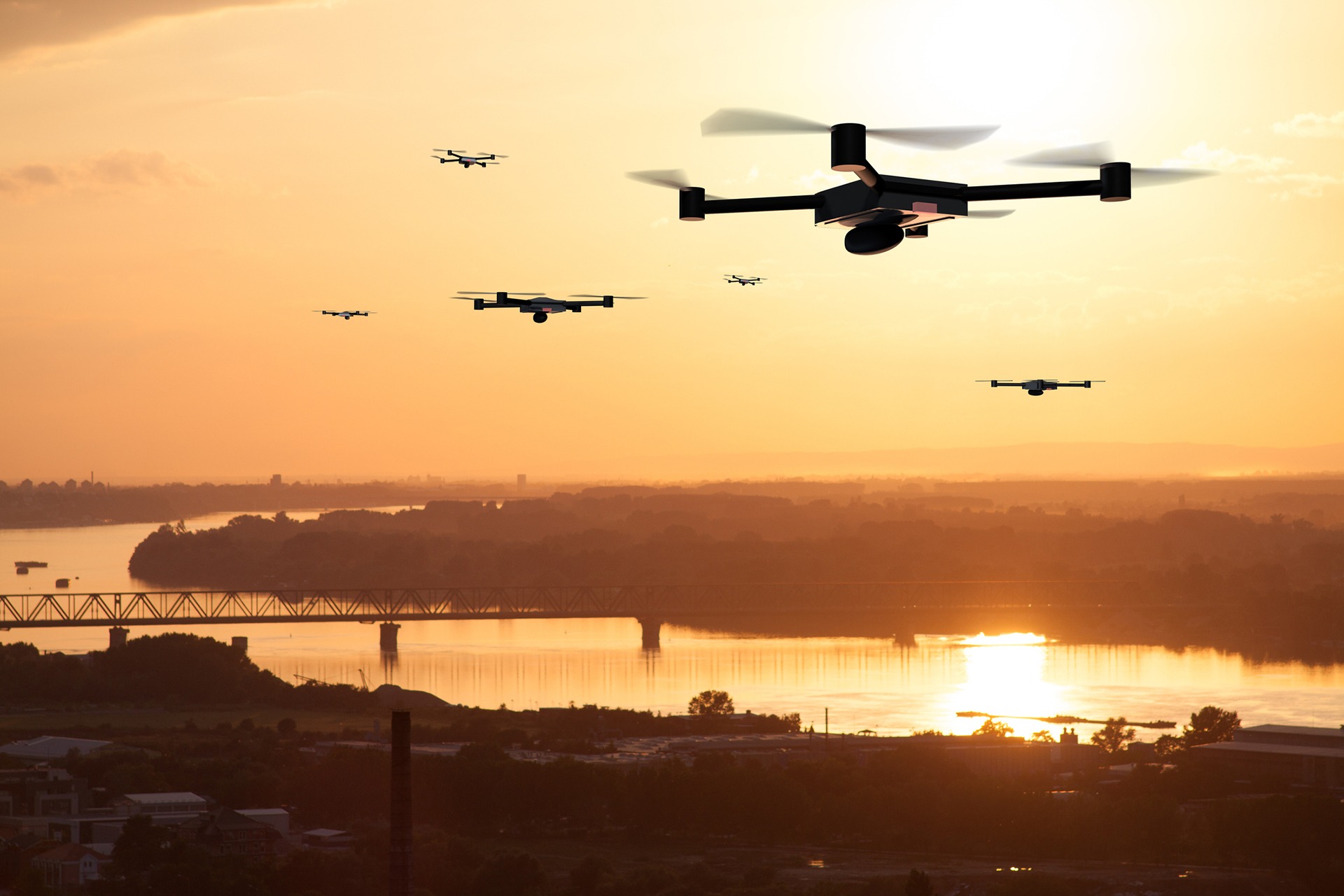
How to enable the drone economy faster while overcoming major obstacles
The number of Unmanned Aerial Vehicles (UAVs) sold worldwide is increasing steadily. Overall market size could increase up to US $30 billion in the next 10 years, with value of services reaching $50 billion in the next five. Yet, even with this optimistic forecast, several market enablers lag. Unmanned Traffic Management (UTM) service must focus on three key elements to transform the business model and drive the market: (1) integration with controlled Air Traffic Management (ATM), (2) technical architecture and regulatory framework of duties, and (3) communication link between pilot, UAV, and UTM. In this Viewpoint, the first of four, we examine actions taken by the most progressive countries and the solutions they are pursuing to enable the sector to thrive. With no one-size-fits-all solution, what are the key challenges going forward?
UTM – Key infrastructure for UAVs
It’s no secret that the UAV market – specifically, drones – forecasts show it as among those with the highest growth potential and expectations. Many industries and sectors (both traditional and innovative) are actively striving for profitable UAV application, and all the necessary solutions are there. Research institutes estimate that UAV services could top $50 billion in the next five years. Clearly, the tipping point is moving forward year by year, leaving the market in limbo.
The degree to which UAVs are deployed and whether they will bring the promised efficiency and effectiveness largely depends on the current unsettled, very fragmented regulation environment. Major obstacles are: How easy or difficult will it be to coordinate and manage multiple UAV operators in a single given airspace? How challenging will it be for UAV operators to engage with the entity responsible for UTM and administration of unmanned airspace? Finally, how “painful” will it be to access and use the airspace?
UTM is among the key infrastructures to unlock this potential. These entities can authorize, regulate, track, and control all UAV flights made under different operational categories; for example, in the European U-space, they are classified as open, specific, or certified. Arthur D. Little estimates that overall potential revenues of European UTM/U-space service providers (UTM/ USPs) would reach about €600 million in revenues (around 7%-8% of pre-COVID air navigation service provider [ANSP] revenues) per year based on the number of flying commercial UAVs, which is expected to exceed 400,000 between 2030- 2040.
As shown in the figure below, the UAV ecosystem maturity level is at the early stage, as advanced operations need enablement from technology developments, awareness of end clients, and system-wide controlling of operations. The strategic importance of UTM is associated with future applications of UAVs, which are far from real deployment: logistics and parcel delivery, urban air mobility (UAM) (e.g., air taxi), and integration of UAV in the upper sky with classic ATM functions. These applications would have an additional positive impact on UTM economics, but they are not yet quantified. Ultimately, UTM will switch the paradigm of traffic management, since it is a digital native and relies heavily on automation to quickly and efficiently manage thousands of flights per hour with minimal effort.
This Viewpoint is the first of four that looks inside the world of UAV: the first is about regulation and UTM; the second will define possible operator business models for service deployment; the third will assess gaps to close in technology and innovation; and the fourth will look at the rising interest in investment funds (both private entity and venture capital).
So what actions are the most progressive countries taking, and what solutions are they pursuing to enable the sector to thrive? Should others follow or aim for alternate provisions? Looking ahead, it’s clear there is no one-size-fits-all solution.
Integration with ATM and controlled airspace
Many countries believe that ANSPs should take on UTM. While this may be the obvious solution if UAVs were limitedly employed for long-distance people (or freight) transportation at high altitudes, it is less so when we consider near-future possibilities. Thus, we must rethink the management of airspace to exploit the full potential of UAVs.
Currently (and foreseeably), UAVs, even in commercial application, are much different from the manned aircraft we are used to. First, they are in much greater numbers than manned aircraft and thus imply a huge workload for air traffic controllers to grant flight permissions and monitor traffic. Second, UAVs are applied for much shorter distances and at much lower altitudes. Third, they present a lower risk than manned aircraft. In the future, UAVs will require complete integration into all environments and classes of airspace in order to operate safely and efficiently alongside manned aircraft, especially with regard to larger drones that will fly at higher altitudes. This step is very challenging, as the two traffic monitoring models are on different sides: UTM is software-based, leveraging data, while ATM involves human operators to keep skies safe with the help of radar.
Creating a regulatory landscape compliant with the actual airspace environment will be another challenge for the integration of both traffic management systems. It will be necessary to put in place regulations for each state for procedures in case of bad weather/congestion. Regulatory aspects must overcome boundaries defined by governments that continue to lag behind drone technology innovation.
For effective traffic management, drone identification systems must share flight data with operators, authorities, and manned objects. Other technical constrains must be overcome, too: (1) improvements regarding facilities that collect/share data with other systems and (2) advanced autonomous functions (e.g., dynamic airspace allocation) that allow for safe flights. Furthermore, information coming from UAVs should merge with data from traditional ATM systems (i.e., radar) and sensors from different drone surveillance networks. Then, it could be possible to detect unauthorized flights over critical infrastructures or realtime tactical conflict with cooperative drones or manned aircraft. To realize this integration, it will be fundamental to seek a new approach to traffic management – involving authorities, ANSPs, and technology players.
UTM deployment models – Market vs. monopoly, integrator vs. orchestrator
Up until now, the growth and usage of UAVs has occurred in an almost unregulated environment; most applications have been for leisure or localized works in a Visual Line of Sight (VLOS) setup. Recently, however, Civil Aviation Authorities (CAAs) have issued their first rules aimed at regulating the sector, as there could be severe harm for people and things if not properly managed. In the last few years, many countries have begun to move in the direction of creating a separate entity for unmanned traffic management – the UTM operator. We believe these countries will be at the forefront of UAV deployment. UTM under development, however, is very different than in real settings, where its role ranges from providing pure traffic information to being a complete duplicate of ATM controllers that serve UAVs only. UTM does, however, share its main purpose and some core responsibilities with ATM.
Most commonly, ATM is not losing any authority. It remains responsible for licenses and flight permission issuance where manned traffic management can be affected. UTM is mainly created as an intermediary between ATM and UAVs. Where manned air traffic is not in danger from UAVs, most decisions are taken or enabled by UTM. In some cases, operators can intervene to modify flights if they pose certain risks. But what are the striking differences in the approach to UTM?
UTM will be the framework through which new regulation will deploy effectively. The US, Japan, and Europe are more advanced in defining rules and procedures in overseeing expected UAV traffic. The UTM system must manage drones in several phases, such as pre-flight, in-flight, and post-flight.
These activities, which include actors playing different roles in the value chain of the UTM market, are regulated differently and, as shown in the figure above, are summarized under three main models:
- Integrated model – a designated entity that bears the exclusive concession to provide UTM services from registration to flight services at a regulated tariff by CAAs.
- Coordinated model – the presence of a common information service (CIS) provider that operates as a central coordinator in charge of providing fundamental consolidated traffic data to authorized USPs.
- Peer-to-peer (P2P) model – the existence of a flight information management system that collects and distributes mainly external data, along with several USPs responsible for covering most flight services that can coordinate with each other.
Countries worldwide are deploying different models of UTM; in some cases, they are applying a P2P model with the presence of a flight information management system (FIMS), while others are employing a coordinated model with the presence of a centralized drone traffic management system.
There are several pros and cons to consider (see figure above). In particular, the US is developing a P2P model via a FIMS managed by the Federal Aviation Administration (FAA), which acts as a bridge with ATM; furthermore, the FAA with its FIMS interacts as an information agent with USPs. All the USPs, following standards and protocols, support the mission of the unmanned aircraft system (UAS) by communicating with each other to coordinate operations. Russia, however, plans to fully integrate its UTM and ATM systems through a continuous exchange of information, creating a centralized system of traffic management. The integrated system will provide information about geo-fencing, flight clearance, surveillance, and flight traffic capacity based on cloud technology.
As for Europe, each country embraced its own model up until recently, when the EU Aviation Safety Agency (EASA) and the European Commission issued a new regulation aimed at adopting the coordinated model. Every member state should designate a CIS for every U-space to represent a single trustworthy source of information that supports exchange of data and coordination between all USPs.
The figure below illustrates a map of different approaches by the most progressive countries in building UTM regarding deployment model and approach to service development. Germany and Italy are leveraging joint ventures and partnerships between ANSPs and industrial players (Deutsche Telkom, Leonardo), while Holland, Belgium, and Poland are building a UTM system via the help of technology providers (Unifly, AirMap, etc.). The vision of an open market revolutionizes the business model for early UTM ventures. The value at stake for each player is still uncertain, especially if services have to be distributed between the CIS and several USPs. Most likely, regulated (stable) source of revenues (e.g., registration fees) will be largely granted to the CIS, while USPs will compete in flighttracking services and other value-added services.
These differences come in myriad forms, and which UTM model is most beneficial is disputed among countries, even those in close proximity. Both countries and entities must take on the burden of creating and managing UTM operators – or make the market decide, according to entrepreneurial ventures. Which model will become most profitable and less risky for investors is yet to be tested. Thus, it will be crucial to build a financially sustainable system to guarantee the continuity of services and the needed safety standards in place for UAV operators.
Going BVLOS – Importance of communication link
A UTM system functioning well needs an exchange of information with UAS operators; these interactions are divided into two phases: pre-flight interactions and flight interactions. Today, communication between the UAV and the pilot ground control station is established through short-range radio waves satisfying two main functions: command and control (C2) and data streaming to/from payload.
The development of the most advanced UAV use cases (e.g., urban air mobility or parcel delivery) relies on the possibility to operate in the BVLOS environment, thanks to a stable, ubiquitous communication link between the UAS and UTM. There is still no common protocol, however, to communicate basic flight parameters with UTM systems. Usually, there are two ways to perform this function: (1) make an exchange via cloud applications using mobile device of the UAS operator, or (2) rely on the UAV antenna for direct communication. To realize this connection, there are two main bearers: terrestrial networks based on mobile 4G/5G technology and satellite communication systems.
Mobile terrestrial networks fit perfectly with the micro-drone structure and can meet requirements for both C2 and payload links. Thanks to 5G, the mobile network can guarantee up to 20x higher overall bandwidth and 90% lower latency. However, terrestrial networks do not guarantee coverage outside the densest areas and at higher altitudes. Public networks may lack reliability and availability of signal, making them difficult to use in safety-critical operations.
Satellite, on the other hand, shows a much stronger link suitable for critical missions and could be the only option to operate in remote areas and for drones flying at very long range/high altitudes. But even though the bandwidth requirement for UTM systems is reasonable (300 Kbps), satellite link performance lags far behind terrestrial networks in terms of latency and the bandwidth cost could be very expensive for small operators. We believe that, in the future, the most important applications will adopt hybrid terrestrial-satellite links, where the onboard equipment will choose the best link according to environmental conditions to maintain stability and reliability.
Conclusion
While first movers in UTM are ANSPs, the direction toward an open, competitive market could see the entrance of different players that may want to become USPs. Technology issues will take priority, but whether UTM will become profitable remains unproven. Many USPs may want to leverage the client base and integrate them into the value chain (i.e., operators, marketplace, insurance, maintenance). A new market mindset will be key for capturing value from clients in contrast with the slow, regulated world of ANSPs. Questions also remain for the regulatory bodies: Which UTM model will best suit the needs of a given country? Which will support the spread of UAVs? Which will reduce the operational burden on ATM and state budget? Many factors must be considered and evaluated by CAAs and private players to avoid fatal mistakes that would outweigh the potential benefit of UAVs.









